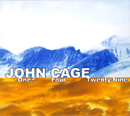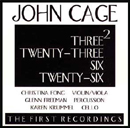| Record companies, artists and publicists are invited to submit CDs to be considered for review. Send to: Jerry Bowles, Editor, Sequenza 21, 340 W. 57th Street, 12B, New York, NY 10019 |
Latest Posts
John Adams - Shaker Loops
Icebreaker: Cranial Pavement
"Poets" Redux
In Praise of Poets: Jerry Gerber, Composer
Earthshine, Beata Moon
The Contrabandista, The Foresters
Dreams Within a Dream, Cary Boyce
The Book of Moonlight – Violin Music by Larry Bell
Best CDs of 2004
Rudolf Friml Piano Works
Record companies, artists and publicists are invited to submit CDs to be considered for our Editor's Pick's of the month. Send to: Jerry Bowles, Editor, Sequenza 21, 340 W. 57th Street, 12B, New York, NY 10019



|
Archives
Saturday, December 18, 2004
Saturday, December 25, 2004
Friday, December 31, 2004
Wednesday, January 05, 2005
Monday, January 10, 2005
Thursday, January 13, 2005
Thursday, January 20, 2005
Sunday, January 23, 2005
Monday, January 24, 2005
Saturday, January 29, 2005
Wednesday, February 02, 2005
Thursday, February 03, 2005
Monday, February 07, 2005
Tuesday, February 08, 2005
Friday, February 11, 2005
Monday, February 14, 2005
Wednesday, February 16, 2005
Tuesday, February 22, 2005
Monday, February 28, 2005
Sunday, March 06, 2005
Monday, March 07, 2005
Wednesday, March 09, 2005
Sunday, March 13, 2005
Friday, March 18, 2005
Monday, March 28, 2005
Saturday, April 02, 2005
Monday, April 11, 2005
Sunday, April 17, 2005
Tuesday, April 19, 2005
Monday, April 25, 2005
Monday, May 02, 2005
Monday, May 09, 2005
Tuesday, May 17, 2005
Tuesday, May 31, 2005
Monday, June 06, 2005
Thursday, June 16, 2005
Sunday, June 19, 2005
Sunday, July 10, 2005
Wednesday, July 13, 2005
Sunday, July 24, 2005
Friday, July 29, 2005
Monday, August 08, 2005
Monday, August 22, 2005
Wednesday, August 24, 2005
Friday, September 16, 2005
Sunday, September 25, 2005
Tuesday, October 04, 2005
Tuesday, October 18, 2005
Monday, October 24, 2005
Tuesday, November 01, 2005
Monday, November 07, 2005
Saturday, November 12, 2005
Wednesday, November 16, 2005
Tuesday, November 29, 2005
Friday, December 16, 2005
Monday, January 09, 2006
Thursday, January 12, 2006
Thursday, January 19, 2006
Tuesday, January 24, 2006
Thursday, February 02, 2006
Monday, February 13, 2006
Wednesday, February 15, 2006
Wednesday, March 01, 2006
Sunday, March 19, 2006
Sunday, March 26, 2006
Friday, March 31, 2006
Sunday, April 09, 2006
Monday, April 10, 2006
Thursday, April 20, 2006
Friday, April 21, 2006
Thursday, May 11, 2006
Thursday, May 18, 2006
Saturday, May 20, 2006
Friday, June 02, 2006
Tuesday, June 06, 2006
Friday, June 16, 2006
Monday, June 19, 2006
Sunday, June 25, 2006
Monday, June 26, 2006
Monday, July 10, 2006
Thursday, July 13, 2006
Thursday, July 20, 2006
Friday, July 21, 2006
Sunday, July 23, 2006
Thursday, August 03, 2006
Wednesday, August 09, 2006

|
|
Wednesday, February 02, 2005
John Cage, Number Pieces
 Over the past decade, percussionist Glenn Freeman and violinist Christina Fong of OgreOrgress productions have turned out a series of outstanding new music recordings by Morton Feldman, Maria de Alvear, Alan Hovhaness and others from their unlikely beanstalk in Grand Rapids, Michigan. The most ambitious of their projects, though, may be the four (so far) CDs dedicated to John Cage's late period "Number Pieces". Over the past decade, percussionist Glenn Freeman and violinist Christina Fong of OgreOrgress productions have turned out a series of outstanding new music recordings by Morton Feldman, Maria de Alvear, Alan Hovhaness and others from their unlikely beanstalk in Grand Rapids, Michigan. The most ambitious of their projects, though, may be the four (so far) CDs dedicated to John Cage's late period "Number Pieces".
Cage wrote some 45 of these pieces over the last five years of his life, aided by software developed by his long-time assistant Andrew Culver. By then, Cage was about to turn 80 and had started to become almost respectable in proper music circles. All of the elements that had interested him as a composer throughout his mature career--indeterminacy, nonunderstanding, inconsistency, imitation, variable structure, contingency, anarchy—are present but there is something else. The pieces bear some spiritual kinship to the paintings that Wilhelm de Kooning did after he was old and certifiably mad—they weren’t bad or even that different from what he did before, but they defy conventional analysis. The artist has simply moved to a place where reality, whatever that is, is even more random and abritrary.
Rob Haskins' liner notes for One4 Four and Twenty-Nine, the latest release in the OgreOgress series, are printed in small type running around in circles on the CD itself which make them unreadable for vertigo-challenged geriatrics like me but the idea seems to be this: The title of each work in the Numbers Series is a number written out as a word (One, Two, Fourteen etc.). That indicates the number of performers for which the piece was composed. If Cage wrote several works for the same number of performers, he would make a further distinction in the title by adding a superscript numeral; for instance, Four (1989) is for string quartet, while Four4 (1991) is a quartet for percussion.
As with all the late Number Pieces, One4 Four and Twenty-Nine use what Cage called ”time brackets.” The instrumentalists are assigned parts which contain mostly single notes and chance-distributed time brackets indicating the period of time (as measured by a stopwatch) within which the notes are to be played. Imagine a forest coming alive at dawn, an owl wakes up the turkeys who wake up the squirrels who wake up the birds and so on (without the stop watch, of course). A performer might begin to play, say, at any time between 0’00 and 1’00 and end somewhere between 0’30 and 1’30.
 One4 is for a single percussionist--in this case, Glenn Freeman--playing a variety of percussion instruments of his own choosing, per Cage’s instructions. Four is scored for standard string quartet and was designed by Cage (through the use of a limited range of tones) so that any player can play any part. The piece is divided into three five-minute sections; at the end of each section, the players switch parts and start at the top. The piece can last ten, twenty or a full thirty minute performance, by simply omitting a section or two. Freeman and Fong have taken the idea a step further by splitting up each section with separate index points, two versions of each, to allow the listener to design his or her own performances. One4 is for a single percussionist--in this case, Glenn Freeman--playing a variety of percussion instruments of his own choosing, per Cage’s instructions. Four is scored for standard string quartet and was designed by Cage (through the use of a limited range of tones) so that any player can play any part. The piece is divided into three five-minute sections; at the end of each section, the players switch parts and start at the top. The piece can last ten, twenty or a full thirty minute performance, by simply omitting a section or two. Freeman and Fong have taken the idea a step further by splitting up each section with separate index points, two versions of each, to allow the listener to design his or her own performances.
 Twenty-nine is scored for two timpanists, two percussionists, one pianist (bowed, with rosined string around the desired string), ten violists, eight cellists and six contrabassists, all with their own parts. This would obviously be a budget-busting array of required musical resources so Twenty-Nine is performed by only four people (Freeman; Christina Fong, violin and viola; Karen Krummel, cello; and Michael Crawford, contrabass) using overdubbing to capture all the parts. Twenty-Nine was designed so that it could be played alone, or combined with up to two other pieces, Twenty-six and Twenty-eight. Instructions are included. Twenty-nine is scored for two timpanists, two percussionists, one pianist (bowed, with rosined string around the desired string), ten violists, eight cellists and six contrabassists, all with their own parts. This would obviously be a budget-busting array of required musical resources so Twenty-Nine is performed by only four people (Freeman; Christina Fong, violin and viola; Karen Krummel, cello; and Michael Crawford, contrabass) using overdubbing to capture all the parts. Twenty-Nine was designed so that it could be played alone, or combined with up to two other pieces, Twenty-six and Twenty-eight. Instructions are included.
Is it music? Yes. Is it important music? Maybe. Is it fun to listen to? Depends on your tastes. Should you order a copy from OgreOgress? Absolutely, and get the other three in the series, too.
 What is most encouraging is that even in George Bush’s dumbed-down America there are people like Glenn Freeman and Christina Fong who believe that ideas matter and who have the energy, commitment and talent to explore and record new music and avenues of performance that will never have a large commercial payoff. Willy Wonka described them best: "We are the music makers, and we are the dreamers of the dreams." The world needs more dreamers and music makers. What is most encouraging is that even in George Bush’s dumbed-down America there are people like Glenn Freeman and Christina Fong who believe that ideas matter and who have the energy, commitment and talent to explore and record new music and avenues of performance that will never have a large commercial payoff. Willy Wonka described them best: "We are the music makers, and we are the dreamers of the dreams." The world needs more dreamers and music makers.
posted by Jerry Bowles
1:29 AM
|
|




